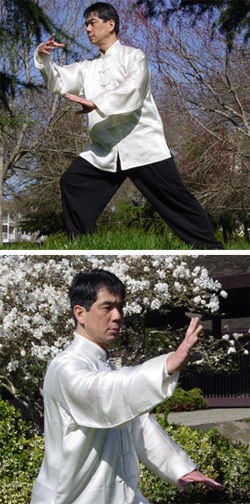Classes

Yang style Taiji - Ward Off & Brush Knee Push
A wide range of classes are available for beginners as well as more experienced practitioners interested in going deeper into their Taiji practice. Classes include Beginning Yang Style, The 24 Forms, The 42 Sword Form, Push Hands and more (complete list below).
Classes are taught in scheduled group sessions at various locations in Vancouver. Special arrangements can be made for corporate groups, semi-private groups and private classes. Contact Anthony for details.
“Anthony is an excellent instructor. His knowledge, skill and humour make learning Tai Chi both interesting and fun…I’m hooked.” – David Crumpton, Pacific Blue Cross
Classes are available in the following styles:
Beginning Yang Style
This program is intended for new people, with it’s focus on fundamental techniques. The program begins with some basic “Qigong” postures (energy exercises) followed by foundational movements, then progress into the “Beginners set” which is the foundational movements put together as a form.
The 24 Forms
In 1956 the “Chinese National Sports Committee” commissioned the foremost renowned Taijiquan experts to develop a set of forms suitable for everyone of all ages and physical ability to practice. The result was the creation of “The 24 forms” which retains all the essential principles of Taiji and is based mostly on the “Yang style”.
Sun Style – short form (Taiji for Arthritis)
This program was developed by Dr. Paul Lam in conjunction with a team of Taiji and medical experts. Scientific study has shown that this program is effective in relieving the pain and stiffness associated with Arthritis and as a result improves the quality of life. It is supported by Arthritis Foundations around the world. Additionally, it is an ideal introduction to the Sun Style Taiji. (Certified by Dr. Paul Lam to teach the above program)
The 42 Forms
This form is considered to be one of the best forms of Taiji ever created. It contains most of the essential principles and characteristics of the 5 major styles (Yang, Chen, Wu, Wu Xiang and Sun) and was created by Professor “Men Hui Feng”, former head of the prestigious “Beijing Institute of Physical Education” and also the creator of “The 48 Forms”. The 42 forms is suitable for all levels, from beginner to the most advanced Taijiquan practitioner.
36 Forms Chen Style
This form was created from the original 83 forms taught by Chen Fake. It is the basic framework for Professor “Kan Gui Xiang’s” later creation of the official Chinese National Competition Forms (The 56 competition forms). Chen Style is the oldest and original style of Taijiquan. It contains more complex and vigorous movements than other styles, as well as being more directly applicable to martial arts. Practitioners of this style can therefore expect to achieve a higher level of physical fitness and mental relaxation more quickly.
Sun Style 73 Forms
This form is characterized by powerful Qigong content, agile steps and flowing movements. This form was created by Professor Men Hui Feng of the “Beijing Institute of Physical Education” and is noted for it’s Chi development. The 73 forms was also created as a competition form.
The 32 Sword Form
The sword is a beautiful extension and expression of the essential principles of Taiji. The 32 sword form is based on the Yang Style and is suitable for people of all ages.
The 42 Sword Form
This form was created by Prof. Kan Gui Xiang to complement the 42 Forms and is the official Forms for major international competitions. The Sword is a beautiful extension of the essential principles of Taiji.
Traditional Yang Style Sword
This sword form as the name implies, is based on the Yang Style and is a beautiful expression of the art of Taiji swordsmanship.
Push Hands
In this program we will isolate and discover the 8 basic energies (Peng, Lu, Ji, An, Cai, Lie, Zhou and Kao – Ward off, rollback, press, push, plucking, splitting, elbowing and shouldering. The program begins with basic exercises designed to cultivate sensitivity and sticking/adhering abilities, then progresses into the traditional four hands routines. ‘Push Hands’ develops understanding of energy and balance.
